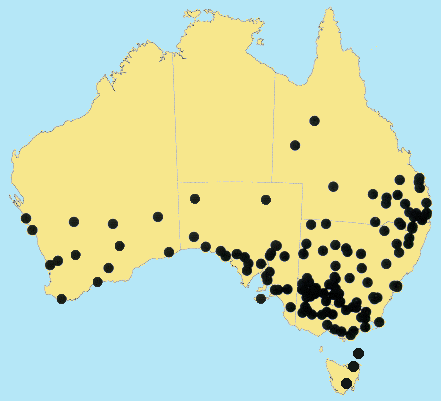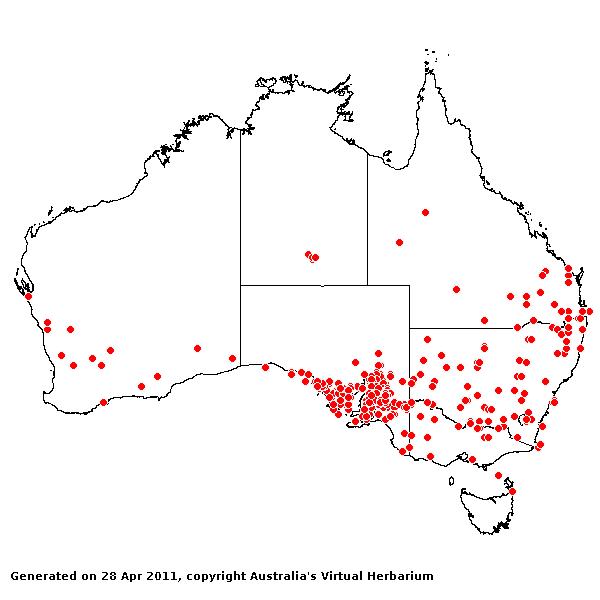Hordeum glaucum* Steud. Syn. Pl. Glumac. 1: 352 (1854).
Classification. (GPWG 2001) : Subfamily Pooideae. Tribe Triticeae.
Type of Basionym or
Protologue Information: France: 'pl. de l'ouest de la France', 29 June
1879, Gadecau s.n. (HT: ?; NT: BM).
Recent synonyms:
Hordeum glaucum, H. murinum subsp. glaucum.
Key references
(books and floras): [1981] M.Lazarides in J.Jessop (ed)., Flora of
Central Australia (433), [2002] D.Sharp & B.K.Simon, AusGrass,
Grasses of Australia, [2006] J.Jessop, G.R.M.Dashorst, F.M.James, Grasses
of South Australia (269), [2008] S.W.L.Jacobs, R.D.B.Walley &
D.J.B.Wheeler, Grasses of New South Wales (278), [2009] A.Wilson (ed.). Flora
of Australia, Vol 44A. Poaceae 2 (115).
Illustrations:
[2006] J.Jessop, G.R.M.Dashorst, F.M.James, Grasses of South Australia (269, fig. 208), [2008] S.W.L.Jacobs,
R.D.B.Whalley & D.J.B.Wheeler, Grasses of New South Wales, 4th edn
(278).
Habit. Annual.
Culms geniculately ascending, 6–60 cm tall, 3–5 -noded. Leaf-sheath auricles
present. Ligule an eciliate membrane, 0.5–1 mm long, hyaline. Leaf-blades flat,
2–20 cm long, 2–8 mm wide. Leaf-blade surface scabrous, indumented.
Inflorescence.
Inflorescence solid, a spike. Rhachis fragile at the nodes.
Spikelets.
Spikelets sessile, 1 in the cluster. Companion spikelets developed, containing
empty lemmas or male, 7–11 mm long. Fertile spikelets 1-flowered, comprising 1
fertile floret(s), without rachilla extension, lanceolate, dorsally compressed,
7–12 mm long.
Glumes. Glumes
similar. Lower glume subulate or oblong, chartaceous or coriaceous. Lower glume
apex awned. Upper glume subulate, 25–30 mm long.
Florets.
Fertile lemma 6–13.5 mm long, without keel, 5 -nerved. Lemma apex awned, 1
-awned. Median (principal) awn 0–50 mm long overall. Anthers 3.
Continental
Distribution: Europe, Africa, Temperate Asia, Tropical Asia, Australasia,
Pacific, North America, South America, and Antarctica.
Australian
Distribution: Western Australia, Northern Territory, South Australia,
Queensland, New South Wales, Victoria, Tasmania, Lord Howe, Christmas Is.
Western Australia:
Helms, Austin. Eucla, Irwin, Drummond. Northern Territory: Central Australia
North, Central Australia South. South Australia: Lake Eyre, Nullabor,
Gairdner-Torrens Basin, Flinders Ranges, Eastern, Eyre Peninsula, Northern
Lofty, Murray, Yorke Peninsula, Southern Lofty, Kangaroo Island, South-eastern.
Queensland: Burke, Port Curtis, Leichhardt, Wide Bay, Darling Downs,
Moreton, Gregory North, Warrego, Maranoa. New South Wales: North Coast,
Central Coast, South Coast, Northern Tablelands, Southern Tablelands,
North-Western Slopes, Central-Western Slopes, South-Western Slopes,
North-Western Plains, South-Western Plains, North Far Western Plains, South Far
Western Plains. Victoria: East Gippsland, Eastern Highlands, Gippsland
Plain, Lowan Mallee, Murray Mallee, Riverina, Wimmera. Tasmania:
Furneaux Group, North East, East Coast.
Notes.
This species, along with H. leporinum and H. murinum, is a
widespread component of annual pastures in Australia. However, while it
provides useful early feed it is considered undesirable because its sharp seeds
can enter the eyes, skin and wool of sheep with resulting loss of productivity.
In cereal-growing areas it can act as a host to several cereal diseases.
All
states and territories. Flowers all year.



